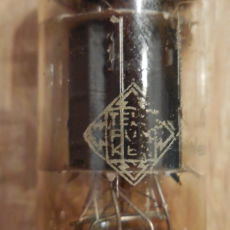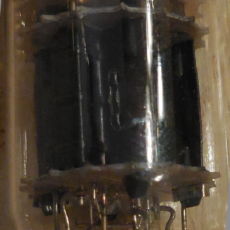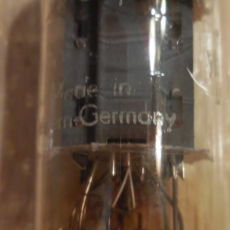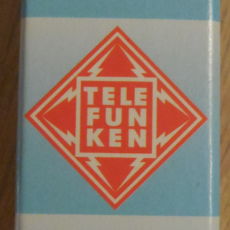Tube Rolling the Xduoo Ta-01b, Ta-10, and Ta-20 (12au7) Amps.
This is the second installment of the tube Rolling the Xduoo Series. The First focused on the 6J1 tube and the Ta-02 and Ta-05 amplifiers. For those who aren’t familiar with tubes, there is also the Intro to Tubes that will help get you up to speed.
The 12au7 is arguably the mainstay of the Xduoo line up as it is used as a preamp tube in the bulk of their tube models. Starting with the Ta-01b, a single 12au7 is used as a preamp for a solid state current amplifier, the Ta-03s is an all tube amplifier with a single 12au7 preamp feeding a pair of 6s19P power tubes (The Ta-03s will be covered in installment 3), the Ta-10 again uses a single 12ua7 preamp to feed a solid state current amplifier, the Ta-20 expands on the Ta-10 by using a pair of 12au7s for preamps and balanced solid state current amplifiers. And finally, the soon to be released Ta-30 uses a pair of 12ua7 preamps and utilizing the 5u4G rectifier tube (This amp will be covered in installment 4). As you might guess, the 12au7 is a versatile tube and is seen a lot in preamp functions do to its low output power.
The 12au7 is a dual triode tube, that can trace its heritage back to the 6c4s (EC90) of the 1940s. It was found that many applications used pairs of EC90 tubes and the 12au7 was born as a way to conserve space, power, and heat by combining the two triodes in a single bottle. Because it was designed to replace two tubes, the filament (heater) is center tapped and can use either 6.3V at 300ma or 12.6V at 150 mA making it easier to directly substitute the 12au7 for the EC90 tubes without additional changes to the surrounding components. Because of this, data sheets will usually list two values for filament current, but may list one or the other so variation in how the tube is documented sometimes causes confusion.
Since its introduction, the 12au7 has found uses in all kinds of applications including audio, computer use (both analog and digital), radar and military applications, TV, radio, and many others. Because of this widespread and extremely varied use, not all 12au7s are created equal. Some made specifically for computer use were more concerned about cutoff and saturation (on/off) and less about anything in between, others were made especially for audio use and are much more concerned with micro-phonics. Military tubes were often designed for vibration resistance, long-life, and even voltage fluctuations. All of these factors mean there are a ton of choices of 12au7s to pick from for your amp at every price imaginable, and while all will fit the socket and will produce sound, large differences in sound quality are not uncommon.
Also worth noting, the 12au7 has several siblings (12av7, 12at7, 12ax7) and while they will fit the same socket, it is usually not a good idea to substitute other members of the family unless the device in question specifically allows for it. (As an example the Auris Euterpe uses a 12aT7 tube by default but recommends using a 12aU7 tube when paired with sensitive in-ears as it will lower the overall gain by doing so). Some tubes in the 12a_7 family were designed for audio, and others were not so use of them in audio circuits is not universally recommended either despite some having reported success using 12a_7 tubes in various applications.
The 12au7 can be found with many different names on them and a number of closely related tubes exist as well. For our purposes, I am splitting the chart below into two sections. The first is tubes that are 12au7 tubes and are identical in all pertinent measurements, the second is those that are closely related with the reason they are not exact matches and what must be done to use them successfully.
12au7 tubes:
| 12au7, 12au7a | Common Western name for the tube, often seen made by RCA, GE, Sylvania, and Raytheon in US as well as Mullard, Telefunken, and others in Europe |
| ECC82 | European designation for the tube – most often seen in Telefunken, Mullard, Amperex, and Brimar brands |
| CV491 | British Common Valve Designation for military use – often seen made by Mullard and Brimar |
| 5814 | Mil-spec version of the 12au7 made for US military – also sometimes seen as the 12au7WA. Commonly seen made by Sylvania, Hytron, Phillips, GE, and RCA less commonly found in GE 5-star and RCA Command broadcast series tubes. |
| 6189 | These were made as mil-spec tubes and may have 12au7wa printed on the label and 6189 etched in them or tubes made for industry may only have the 6189 etching without the additional stamp. Also usually seen made by GE, RCA, Siemens, and Mullard. |
Often substituted tubes:
| 6680 | designed for mobile radio use – compensate for variations in filament voltages. These may have higher mu than stock 12au7 but not all will. (Most often Motorola or GE made) |
| 5963 | These use a lower plate voltage than the 12au7 so consult the Vendor before swapping into a 12au7 socket. Most of the time they work fine but if a 12au7 is driven hard it may be too much for the 5963 if placed into the circuit without alterations. Commonly seen made by RCA, Sylvania, GE, and Tung-sol |
| 6085 / E80CC | These require a higher heater current and load is increased as well compared to the 12au7. Consult the maker before swapping these into a circuit designed for the 12au7 .Mu is higher than standard 12au7 as well. Often seen by Phillips, Valvo, Siemens, and Amperex. |
| 12bh7 | These are often recommended as direct replacements for the 12au7, but require a higher heater current and have a much lower plate resistance so again, consult the manufacturer before assuming the amp will support using these. They will have a higher gain as a result of the lower plate resistance when used in 12au7 sockets. Often seen made by Mullard, Brimar, RCA, GE, and Sylvania. |
| 6350 | These are electrically the same as the 12au7, problem is, they are not pin compatible and have heater and grid reversed so without rewiring your amp or use of an adapter they cannot be used (never a drop-in replacement). Commonly seen made by GE and Sylvania |
| 6CG7 | The 6CG7 combines several of the problems we’ve seen above, Pinout is not the same, and they have a higher current draw compared to the 12au7. Requires an adapter or rewire and even then be sure your amp can handle the current demands. Commonly found made by RCA, GC, Raytheon, Amperex, Tung-sol, and Sylvania |
As mentioned previously, the 12au7 is one of the tubes with the largest number of options available on the market to try and while all of them technically fill the same socket, some are certainly better than others in individual applications. For our purposes, we have several Xduoo models to consider, and they use the 12au7 in a couple different ways. First up, the Ta-01b, Ta-03s, Ta-10, all use a single 12au7 as a preamp feeding either a solid state current amplifier (Ta-01b and Ta-10) or feeding power tubes (Ta-3s). In this configuration, a single triode within the 12au7 amplifies the left channel while the other amplifies the right. Since a single triode is being used, gain is less than what is seen in the second design. The Ta-20 and Ta-30 use two(2) 12au7 tubes as preamps. In these designs, the left channel is passed through both triodes of one tube and the right through both triodes of the other before being passed to the current amplifier.
Because of the different usage patterns, balance within the tubes has to be thought of a bit differently. On those amps that use a single tube, the sections need to be fairly closely matched to prevent a channel imbalance. On the models that use multiple tubes (in our context) the tubes need to be balanced between the two, but individual sections within the tube are less critical since the output is summed between the two sections. For example if a tube measures 400/250 for its two segments, that difference may be large enough to hear a channel imbalance in the Ta-10. If the same tube is used in the Ta-20, then as long as the two sections of the other tube add up to 650, the exact balance is less critical. So the other tube in the Ta-20 might be a perfect 325/325 or a less perfect 450/200 without creating an audible channel imbalance since the sections are summed. When buying tubes, pay attention to how well balanced at tube is as even new tubes sometimes have a considerable difference in how sections measure. You may be better served with a used tube with good balance, than a new tube with a larger difference between triodes.
Rare and exotic versions of the 12au7 can easily command several hundred dollars each with extremely rare specimens commanding thousands of dollars. When talking about amps that cost a few 100 dollars tops, it seems unlikely that one would invest more than the cost of the amp in a single tube so I have limited our discussion to tube pairs that can be readily purchased or no more than $100 per pair. There is a quite a selection available in that price range so I don’t feel this restriction hampered my comparison in the least.
| 12au7/12au7a | Year | Type | Notes |
| I tested two versions of the RCA tube made 10 years apart to illustrate the differences that can be found in tubes of different vintages from the same maker. | |||
| RCA | 1957 | black plate / angle getter | The black plate RCA has long been sought after for its sparkle and warmth and some even say it rivals the best of the European made tubes. While I wont go that far, I found the black plates to have good end to end extension with a bit of extra energy in the mids and at the top end adding a bit of warmth and air. These have good imaging and stage and are a good all around choice at roughly 1/2 the price of the European equals. |
| RCA | 1967 | clear top grey plates | The clear-top RCA has become the darling of US made 12au7’s with many Guitar amps either using them or recommending them particularly in the reverb circuitry. For that reason prices have gone up as audiophiles are in competition with Guitar players for the best of the lot. I found the clear-top to have great detail and a relatively linear signature with good extension and above average imaging. Stage is a step above the stock tubes, but a step behind the best in class. |
| GE | 1969 | grey plate 3 mica | These are an early GE tube with the triple mica supports and have excellent stability as a result. These had very low noise floor, and a very balanced signature. Extension was good at both ends with good air up top. If there is a knock on the GE, it is that details seem a bit smoothed over compared to some of the others. These paired better with the Ta-10 and 20 due to the use of a very analytical DAC and less well with the Ta-01b that was already a bit warm and smooth. |
| Sylvania | 1966 | clear top black plate | The Sylvania tube has good bass, a bit leaner mids and then good air up top with a very clean presentation. Imaging is very good as instrument separation is on par with the best I tested. Stage is good but slightly smaller than the Mullards or Telefunkens but larger and more symmetrical than the stock tube. |
| Raytheon | 1960 | black plate | These are labeled as Baldwin tubes and were sold for use in organs. These usually command a lower price and are every bit as good as their Raytheon labeled siblings so don’t pass up a pair just because they say Baldwin or Conn on the side. These have great extension and good tonality with a very linear signature. Stage is a bit better than the stock tube but wont rival the Telefunken for the top spot. These are a really good budget tube and probably the best value pick of the bunch as they can be had for <$20 a pair at times. |
| Mullard | 1958 | Long Plate | The Mullard tube lived up to its reputation of having good end to end extension and a bit of warmth to the signature as a whole and the mids in particular. Stage was good, but not class leading. |
| Telefunken | 1966 | smooth plate, halo getter | These are the most expensive tube in our round up, and there is a good reason. I found the Telefunken 12au7 to have great extension on both ends and good balance all the way through the range. Detail is first rate and imaging is the best of the bunch tested. Soundstage equalled the best of the bunch and was better than most. All in all, if you have the funds or can find these on the cheap, they should be on your short list of tubes to try. |
| ECC82 | |||
| Telefunken | 1963 | smooth plate | The Telefunken tube provides great balance and detail with slightly thin mids so portrays itself as slightly bright. These were impressive in the Ta-01b as it has a bit of warmth form the DAC component so the cleaner mids are appreciated there. One of my favorites in the Ta-01b,but a little thin in the mids for the Ta-10 or Ta-20 applications. |
| Amperex | 1957 | long plate d-getter | The Amperex provided an interesting counterpoint to the Telefunken ECC82 as the mids are a bit warmer and thicker while still maintaining good balance and clarity. The Amperex also had perhaps the largest soundstage of any tested in the group. One of my favorite tubes in the Ta-20 and maybe the best of the bunch for the Ta-10. |
| CV491 | |||
| Brimar | side getter | Another tube with excellent balance and extension on both ends and a bit of warmth without getting syrupy or thick. Not quite as clear as the top performers, but not as thickened as some of the warmer tubes in this test either. This would likely make my favorites list were it not for the fact that a couple others outperformed it and are usually available at a lower price point than the CV491. | |
| 5814 | |||
| GE 5-Star | 1956 | 3-mica D-Getter | This is an early 5-star broadcast tube with the 3rd mica support at the top and has exceptionally low microphonics as a result. The 5-star has good extension at both ends with particularly good top end. Portrayal is clean without a lot of extra warmth but does not come across as thin either. These are a great pairing with the Ta-01b and its slightly warm DAC and a solid pairing with the Ta-10 and Ta-20. These are a safe middle-ground tube, not the best at any one thing, but good at everything. |
| 6189 | |||
| GE JAN 6189W | 1980 | Halo Getter | This is the mil spec version and is a late production version and was the only tube in the round-up I can say I felt disappointed by. These had issue with microphonics in the Ta-10 and Ta-20 and was simply not enough better than the stock tube in the Ta-01b to justify the price point. Most of the tubes in this round up I could happily use in any of the devices tested. This was the only tube in the roundup that wasn’t at home in any of them. |
| RCA | 1954 | black plate 3 mica | This is an early commercial 6189 unlike the military GE and with its triple mica it was considerably more solid and less microphonic than its GE sibling. Sound was clean and well extended with slight warmth and good stage. A solid choice in any of the 3 devices. |
| 5963 | |||
| RCA | 1956 | black plate d getter | This is a mid-priced RCA as the clear-top version is probably the most sought after while the gray plate is usually least expensive. These were a good middle of the road tube as extension was good, bass was superb, clarity was good, and top end air is good. Not a master of any one thing (although bass was close to the best of the day, the RCA also did very little poorly so makes a good “safe” choice. |
| Sylvania | 1953 | clear top-black plate | The Sylvania 5963 had good extension at both ends and a little more warmth in the mids than its other US made rivals. These don’t rival the UK made tubes for mids, but do show a bit more thickness and warmth than many of the others in this roundup. For me, that was a bit too much when paired with the DAC in the Ta-01b, but served me better in the Ta-10 and Ta-20. |
| Tung-sol | 1964 | clear top black plate | These looks suspiciously like an RCA clear top, but are made by Tung-sol using a very similar getter and plate. Sound is nice and clean with good stage and top end. Bass is reasonably well extended but not particularly emphasized. |
| 12bh7 | |||
| RCA | 1973 | Clear Tops | These have very good detail and good dynamics and were easily the best of the three 12bh7 tubes tested. The RCA had the best stage of the three and better instrument separation as well. Good balance with nothing pushed too far forward, but does come across as slightly bright sounding. |
| Sylvania | 1977 | Square getter | These were my least favorite of the 12bh7s as they sounded slighty veiled compared to both the others and had a smaller stage and less detail as well. One of the least spectacular tubes of the roundup. |
| Mullard (IEC) | 196x | Black Plate | The Mullard had good detail and a little heavier bottom end than top so gives the sound a bit of warmth and weight. Detail was good but not quite on par with the RCA. Stage and instrument separation were also acceptable, but not as large as the best tested. |
Well after nearly 200 hours of listening, we have 19 different pairs of 12au7 (or similar) tubes compared to the stock tubes and I can say without a doubt that changing the tubes changes the character or each of the amps tested. To wrap this up, I am going to look at each amp individually and list a couple of options that I feel performed admirably. Remember, we all have our biases so you may still wish to consult the complete list to find the best match for you.
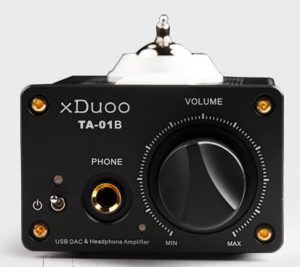 The Ta-01b (depending on generation) uses either the Wolfson or Cirrus Logic DAC chips, both of which have a reputation for a being a bit smooth and warm. This makes the Ta-01b a bit more syrupy with some tubes than the Ta-10 or 20. I found the best pairings to the Ta-01b (Cirrus DAC) were either the Telefunken 12au7, GE 5-star 5814, and the Sylvania 12au7. All of these provide good balance without getting too smoothed over or thick. For those that want a thicker, warmer tone, try the Mullard 12au7. The RCA black Plate 12au7 lands between the two endpoints and is a good compromise pick as well.
The Ta-01b (depending on generation) uses either the Wolfson or Cirrus Logic DAC chips, both of which have a reputation for a being a bit smooth and warm. This makes the Ta-01b a bit more syrupy with some tubes than the Ta-10 or 20. I found the best pairings to the Ta-01b (Cirrus DAC) were either the Telefunken 12au7, GE 5-star 5814, and the Sylvania 12au7. All of these provide good balance without getting too smoothed over or thick. For those that want a thicker, warmer tone, try the Mullard 12au7. The RCA black Plate 12au7 lands between the two endpoints and is a good compromise pick as well.
While the Ta-10 and Ta-20 share a lot of commonality, I did find that they were not identical where tube preference is concerned partially because of the AKM DAC used in the Ta-10 and partially because the Ta-10 uses a single triode per channel while the Ta-20 uses two triodes per channel. Because of the later difference, the Ta-20 takes on more of the tube characteristics more quickly than the Ta-10.

For example, I found the Mullard 12au7 to be a great fit in the Ta-10, but a bit too fluid and smooth in the Ta-20 when combined with a DAC using the same 4490 chip. The Ta-10 has less of a warm tilt than the Ta-01b but still retains some of the same fluidity and smoothness so I liked a tube that gave the sound as much edge as I could retain. Those were tubes like the Raytheon and the GE 5814 that have a nice clean signature with tight control. My wife who prefers a warmer tonality was particularly happy with the Ta-10 (her desktop rig) paired with the Brimar CV491 or the Sylvania 5963 as both were good compromises between detail and warmth.
And our final Amp and the only pure Amplifier in this experiment is the Ta-20. I paired the Ta-20 with an ESS 9038 DAC for most of the testing which gave it a decidedly more analytical and dry sound signature than the other two. For that reason, tube preferences will be those that add back some warmth to the signature and some fluidity that the ESS is typically lacking. If you pair the Ta-20 to something a good bit warmer like the AK series, the choices will shift a bit as they don’t need the degree of added warmth that the ESS benefits from. For that reason, I have two groups of recommendations, the first for cooler pairings and the second for warmer. With the ESS dac, the Brimar CV491, Mullard 12au7, RCA black plate 12au7, and Amperex ECC82 all added a bit of warmth and really were a clear step above the stock tubes. My personal preference was for the Amperex as the best of the lot. With a warmer dac pairing the clear winner were the Telefunken 12au7s (Which some may prefer regardless as they were the most linear tube in the test), a close second, and much easier on the budget were the Raytheon that had good linearity and nearly the extension and detail of the Telefunken while costing less than $25 a pair with a bit of searching.
The Ta-03s uses the 12au7 as well, but since it also pairs it with the 6S19P power tube, I will be covering it in installment 3 of the series (expect this one in early November).
I hope this helps you sort out some of the options available in the 12au7 tube and gives you some idea of which tubes might be best for your application. Remember each tube is a little different and each amp as well so not every combination of RCA/Ta-01b is going to perform exactly the same. I’ve had a lot of fun doing this, and hope you have as much fun trying out various tubes in your Xduoo amplifier. Good luck!




